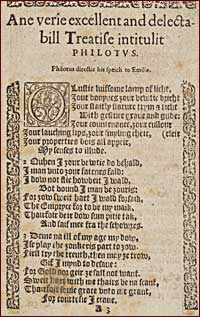Before 1603

Page from 'Basilicon Doron', James's manual on how to be a good king, written for his son.

'Philotus', a bawdy comedy from 1603, one of the few surviving early Scottish plays.
James Stuart was crowned King of Scotland in 1567 when he was just a year old. Although only a baby, he was an important symbol of the Scottish nation, and of the authority of the reformed Church of Scotland.
Fragile country
Both nation and Kirk faced many threats to their survival. Despite its ancient monarchy, Scotland was a fragile country, ruled in the borders and islands by local chiefs and warlords, and with painful memories of wars with England. The Reformation was still in process, with continuing Roman Catholic opposition, and the Kirk itself was divided over structure and doctrine.
As James grew up and took on the responsibilities of ruling Scotland, he gradually managed to bring a greater degree of order to the main areas under his authority. By 1589, he was secure enough to leave Scotland temporarily to sail to Denmark for his bride, Queen Anne.
Cultural revival
As Scotland settled down, a thriving group of poets, translators and dramatists gathered around the royal court. James, who loved writing poetry, was at the centre of this cultural revival. By 1599, he was able to write a book on how to be a successful king, which he addressed to his son, Prince Henry. It looked as though there were good prospects for Scotland becoming a viable nation with a line of cultured kings.
No English heir
But to the south, England – larger, richer, and with a longer tradition of strong central government – had a queen with no children. Queen Elizabeth had executed James's mother, Mary Queen of Scots, one possible successor, and now had no-one to follow her. A king or queen was seen as an essential guarantee of continuity and authority. If England could not produce a monarch, one would have to be imported.


